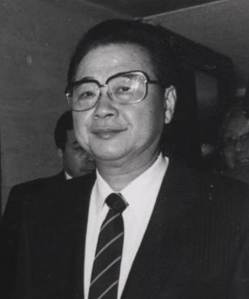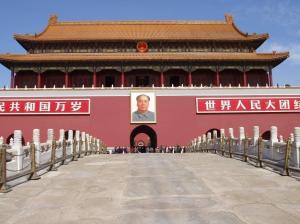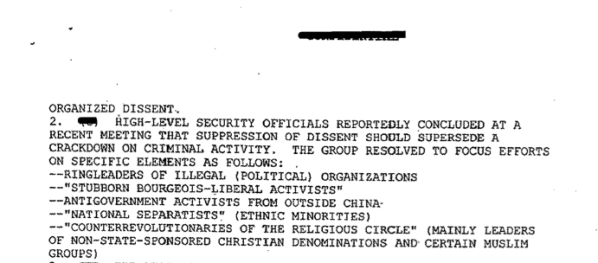For 25th Year in a Row, China Braces for Tiananmen Square Backlash
With the 25thanniversary of the Tiananmen Square massacre at hand, Chinese authorities have erected “more impact resistant” railings around the square itself, rendered Google “largely inaccessible,” detained lawyers, arrested scholars, disappeared activists, and shamed journalists. This is all ostensibly to suppress debate over the military crackdown of the 1989 pro-democracy protests that resulted in the June 4, 1989, massacre of an unknown number of Tiananmen Square demonstrators. Unsurprisingly, the Chinese narrative on one of the most seminal events in its modern history remains, for the most part, sparse.
Luckily, newly declassified documents released to the National Security Archive by the Defense Intelligence Agency (DIA) will help fill in some of the gaps. The DIA documents support the view that there was only a “limited split” in Chinese leadership on using lethal force against citizens, and shed new light on events during and after the protests, complementing previously declassified US diplomatic cables and CIA reports to do so.
The documents show that by April 19, 1989, as pro-democracy demonstrations were beginning to escalate in Beijing, the DIA was reporting that the Chinese government’s response to student demonstrations was “restrained,” but that further “escalation of student protests will most likely trigger a government crackdown.” Nearly a month later, on May 17, demonstrations had so escalated, and it was reported that an estimated 1 million people were protesting in Beijing. According to DIA analysis, onlookers generally supported the demonstrators and provided them with food and money. The same source indicates that by mid-May soldiers were allegedly already refusing to deploy to Tiananmen Square, and that on May 15 a unit in Boading “failed to deploy” despite Beijing’s orders.
In light of growing demonstrations and evidence that the army might be unwilling to use force against the protesters, on May 19, 1989, the DIA reported that the Chinese Communist Party (CCP) seemed to “have little choice but to make serious concessions to the students.” It also noted that government infighting was sending mixed-messages to both students and the army, and that “several group armies” were being moved to Beijing.

Li Peng, China’s premier, declared martial law on May 20, 1989, in response to growing protests in Tiananmen Square (photo credit: World Economic Forum).
By May 18 or 19, however, CCP General Secretary Zhao Ziyang was the only voice opposing military force against the protesters. Upon realizing his calls for moderation had been ignored, Zhao met with students at Tiananmen on May 19, saying, “We have come too late.” Chinese premier Li Peng declared martial law the following day.
Later DIA analysis, drawn from the 1990 edition of the Directory of the PRC Military Personalities, lists the highest estimates of troops used to suppress the protest after Zhao was outvoted at 350,000 men, including “elements from at least 14 of the PLA’s [People’s Liberation Army] total of 24 groups armies (GA’s) and two airborne brigades.”
Chinese leaders tried to promote the appearance of a return to normalcy in the immediate aftermath of the 1989 protests, insisting they were a “counter-revolutionary riot, involving a tiny minority of troublemakers.” The CCP’s security concerns surrounding hosting the 1990 Asian Games, however, belies the portrayal of the protests as a contained riot perpetrated by an unhappy minority. According to a declassified DIA cable, the Chinese government viewed the 1990 Asian Games as “a rite of passage” and as a key point in both the nation’s long-term economic development and returning to “international respectability” after Tiananmen, and a Secret April 16, 1990, report notes heavy security and riot police around Tiananmen Square and the Asian Games stadium in the lead-up to the Games to subdue any potential disruptions. An April 12, 1991, cable further notes that after the Games the PLA generally kept a low profile because the 1989 crackdown “seriously tarnished” its image. In response, the People’s Armed Police force grew to 30,000, and assumed a “greater responsibility for internal security.”
In the years after the 1989 protests, possible June 4 anniversary protests became an annual concern for Chinese leadership, with one May 7, 1990, cable expressing fears that “the situation in China is explosive.” One of the most revealing documents reporting on the Chinese government’s suppression of dissent surrounding the Tiananmen anniversary is a Confidential January 10, 1992, cable. The cable reports that according to a group of Chinese officials, ‘suppression of dissent should supersede a crackdown on criminal activity. The group resolved to focus efforts on specific elements as follows:
- “Stubborn bourgeois – liberal activists”
- Antigovernment activists from outside China
- “National separatists” (Ethnic minorities)
- “Counterrevolutionaries of the religious circle” (mainly leaders of non-state sponsored Christian denominations and certain Muslim groups)’
Taken together, these DIA documents support previous reports that there was only a “limited split” among top Chinese leadership on using force against protesters, but that “both senior officers and rank-and-file soldiers had basic qualms about confronting their fellow citizens with lethal force.” Read in conjunction with diplomatic cables and CIA reports, these DIA documents help provide a more complete picture of the 1989 protests and Tiananmen Square.
Please visit the National Security Archive for more information on Tiananmen Square at 25 years, Tiananmen Square, 1989: The Declassified History, and The U.S. “Tiananmen Papers.”




Comments are closed.